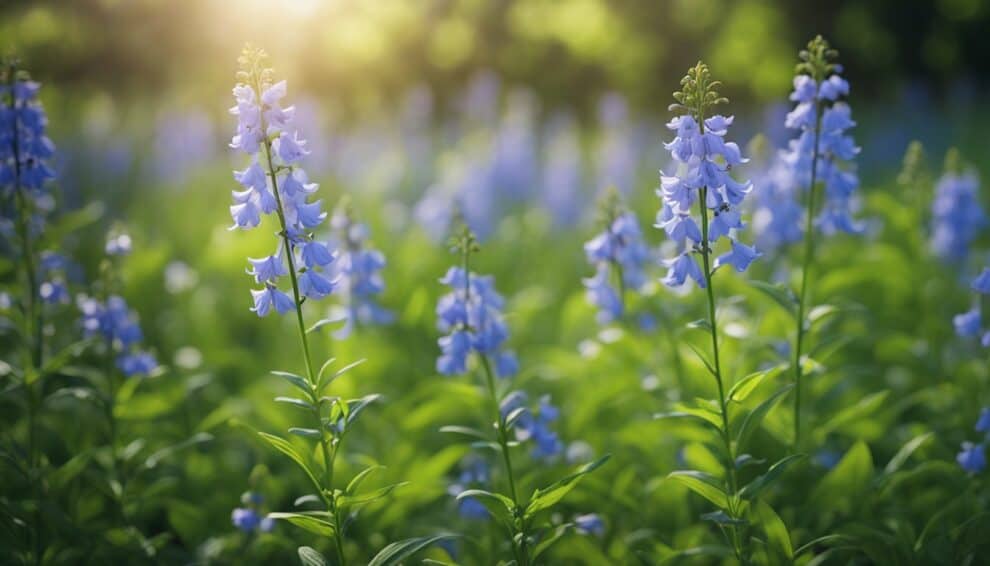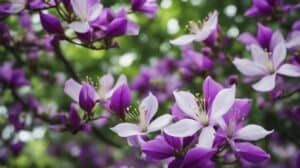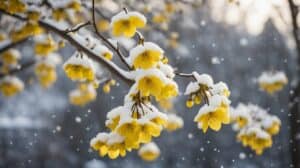Adenophora Lilifolia, commonly known as Ladybells, is a beautiful and fragrant flowering plant that has been gaining popularity among gardeners.
This herbaceous perennial is native to East Asia and is widely cultivated for its lush foliage and bell-shaped flowers that bloom in late summer.

Ladybells are known for their striking appearance and sweet fragrance, making them a popular choice for gardens, borders, and containers.
The plant grows up to 2-3 feet tall and produces long, slender stems with clusters of blue or white flowers that hang like bells.
The leaves are dark green, glossy, and have a lance-like shape, adding to the plant’s aesthetic appeal.
Aside from its ornamental value, Ladybells have been traditionally used in Chinese medicine for their medicinal properties.
The plant has been known to have anti-inflammatory, antitumor, and antioxidant effects, making it a valuable addition to any garden.
With its lush and fragrant appeal, Adenophora Lilifolia is a must-have for any garden enthusiast looking to add a touch of elegance and charm to their outdoor space.
Botanical Profile of Adenophora Lilifolia

Taxonomy and Classification
Adenophora Lilifolia belongs to the Campanulaceae family, commonly known as the bellflower family.
The genus Adenophora comprises approximately 50 species of herbaceous perennials, distributed throughout Asia and Europe.
Adenophora Lilifolia is commonly known as Ladybells or Lilyleaf Ladybells.
Physical Characteristics
Adenophora Lilifolia is a clump-forming perennial that grows up to 3 feet tall. It has lance-shaped leaves that are 4-6 inches long and 1 inch wide.
The leaves are dark green and glossy. The flowers are bell-shaped and hang in clusters from the stem.
They are usually blue or purple, but can also be white or pink. The flowers bloom in mid to late summer and are very fragrant.
Adenophora Lilifolia prefers moist, well-drained soil and partial shade. It is hardy in USDA zones 4-8.
Ladybells are often used in cottage gardens, borders, and woodland gardens. They are attractive to bees, butterflies, and hummingbirds.
In summary, Adenophora Lilifolia is a lovely and fragrant addition to any garden.
Its lance-shaped leaves and bell-shaped flowers make it a standout among other perennials.
Cultivation and Care

Ideal Growing Conditions
Adenophora Lilifolia, commonly known as Ladybells, is a hardy and low-maintenance plant that can thrive in most soil types and a wide range of climatic conditions.
However, to ensure the best growth and health of the plant, it is recommended to grow it in a location that meets the following ideal growing conditions:
-
Sunlight: Ladybells prefer partial to full shade, especially in hot and dry climates.
They can tolerate some direct sunlight, but too much exposure can cause leaf scorching and stunted growth.
-
Soil: The plant prefers well-draining soil that is rich in organic matter.
It can grow in sandy, loamy, or clay soils as long as they are not waterlogged. The ideal soil pH for Ladybells is neutral to slightly acidic (6.0-7.0).
-
Water: Ladybells require moderate watering, especially during the growing season.
They can tolerate short periods of drought, but prolonged dryness can cause the plant to wilt and die.
Avoid overwatering, as it can lead to root rot and fungal diseases.
Planting and Maintenance Tips
Ladybells are easy to grow and maintain, even for novice gardeners.
Here are some planting and maintenance tips to help you get the most out of your Adenophora Lilifolia:
-
Planting: Ladybells can be planted in spring or fall, preferably in a location that receives partial shade.
Dig a hole that is slightly larger than the root ball, and backfill it with a mixture of soil and compost.
Water thoroughly after planting, and mulch the soil to retain moisture and suppress weeds.
-
Fertilization: Ladybells do not require frequent fertilization, but a light application of balanced fertilizer in spring can promote healthy growth and blooming.
Avoid using high-nitrogen fertilizers, as they can promote excessive foliage growth at the expense of flowers.
-
Pruning: Ladybells do not require regular pruning, but you can remove spent flowers and stems to promote bushier growth and prevent self-seeding.
Cut back the entire plant to the ground in late fall or early spring to rejuvenate it and remove any diseased or damaged foliage.
-
Pest and Disease Control: Ladybells are generally resistant to pests and diseases, but they can be affected by slugs, snails, and spider mites.
Use organic pest control methods such as handpicking, diatomaceous earth, or insecticidal soap to manage infestations.
Avoid overhead watering and overcrowding, as they can promote fungal diseases such as powdery mildew and rust.
Landscape and Design Uses

Garden Design Ideas
Adenophora Lilifolia, commonly known as Ladybells, is a versatile and beautiful plant that can be used in a variety of garden designs.
Its lush foliage and fragrant blooms make it an excellent choice for adding texture and color to any garden.
Ladybells can be planted in groups or as a single specimen to create a stunning focal point.
One of the best ways to use Ladybells in garden design is to plant them in a mixed border.
They look great when planted alongside other perennials such as phlox, coneflowers, and black-eyed susans.
Ladybells can also be used to create a cottage garden feel when planted with other traditional cottage garden plants such as roses, peonies, and daisies.
Another great garden design idea for Ladybells is to plant them in a rock garden.
Their delicate foliage and flowers look stunning when planted among rocks and boulders.
They can also be used to soften the edges of a rock garden and add a touch of color.
Companion Plants
Ladybells make great companion plants and can be used to complement a wide range of other perennials.
They look great when planted alongside other shade-loving plants such as hostas, ferns, and astilbes.
Ladybells can also be used to add a touch of color to a woodland garden when planted with other shade-loving plants such as trilliums and bleeding hearts.
In addition to shade-loving plants, Ladybells also make great companions for sun-loving perennials such as daylilies and black-eyed susans.
They can be used to add texture and color to a sunny border and look great when planted in groups.
Overall, Ladybells are a versatile and beautiful plant that can be used in a variety of garden designs.
Whether planted in groups or as a single specimen, they are sure to add a touch of lushness and fragrance to any garden.
Ecological Impact and Conservation

Adenophora lilifolia, commonly known as Ladybells, is a plant species that has a significant ecological impact.
It is an important source of nectar for pollinators, including bees, butterflies, and hummingbirds.
The plant’s lush and fragrant appeal attracts these pollinators, which help to ensure the plant’s reproduction.
Ladybells also play a vital role in the ecosystem by providing habitat and food for a variety of animals, including birds and small mammals.
The plant’s leaves and stems are edible and are a food source for some insects and animals.
Despite its ecological importance, Adenophora lilifolia is facing threats from habitat loss, over-harvesting, and invasive species.
The plant’s natural habitat, including meadows and grasslands, is being destroyed by urbanization, agriculture, and other human activities.
Conservation efforts are underway to protect the Ladybells and their habitat.
These efforts include the establishment of protected areas, such as national parks, and the implementation of sustainable harvesting practices.
It is also important to educate the public about the ecological importance of this plant species and the need to conserve it for future generations.
In conclusion, Adenophora lilifolia, or Ladybells, has a significant ecological impact and plays a vital role in the ecosystem.
Conservation efforts are necessary to protect this plant species and its habitat from threats such as habitat loss and invasive species.
Frequently Asked Questions

What are the ideal growing conditions for Adenophora lilifolia?
Adenophora lilifolia thrives in well-draining soil that is rich in organic matter. The ideal pH range for this plant is between 6.0 and 7.5.
It prefers full sun to partial shade and requires moderate watering.
How often should I water Ladybells for optimal growth?
Watering Ladybells depends on the weather conditions and the soil.
Generally, they require moderate watering, but avoid overwatering as it can lead to root rot. It is best to check the soil moisture level before watering.
Can Adenophora lilifolia thrive in shaded areas?
Adenophora lilifolia can tolerate partial shade, but it prefers full sun. If planted in a shaded area, it may not bloom as well as it would in full sun.
What are the common pests and diseases that affect Adenophora lilifolia?
Adenophora lilifolia is generally resistant to pests and diseases. However, it can be susceptible to spider mites, slugs, and snails.
To prevent these pests, keep the plant clean and free from debris.
When is the best time to plant Ladybells in my garden?
The best time to plant Ladybells is in the spring or fall.
Plant them in well-draining soil, and make sure to water them regularly until they are established.
How do I propagate Adenophora lilifolia effectively?
Adenophora lilifolia can be propagated through division or by seeds. Division is best done in the spring or fall when the plant is not actively growing.
To propagate by seed, sow them in the fall or early spring in a well-draining soil mix.














